The Tramways of
LIMA, PERU
BY
Allen Morrison
This website has three parts.
Go to
Part 1: 1864-1904
Part 2: 1905-1927
Part 4: 1997-
Part 3: 1928-1965
Lima experimented with battery-powered buses in 1905 [see Part 2], but its first permanent autobus service, with vehicles powered by gasoline, was not established until 1920. There were 160 buses on city streets by 1925, 400 buses in 1927. Buses brought serious competition for the trams and Lima Light, Power & Tramways Company (Empresas Eléctricas Asociadas) closed five of its eight urban tram routes in 1928. After that date, rail operation in the central area continued only on the two lines that crossed the river and on the east-west route from Plaza 2 de Mayo to Cinco Esquinas [see map].
Trams on the Malambito-Cocharcas route were replaced by six trolleybuses purchased from Richard Garrett & Sons in Suffolk, England [Transit Journal, New York, 3/1939, p. 85]:
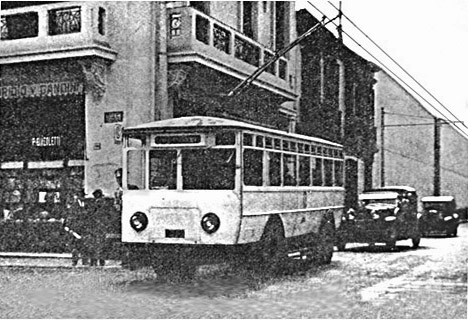
This was the first commercial trolleybus operation - electric buses using overhead wires - in South America. (There had been an experimental line in Mendoza, Argentina, in 1913: see Trolleybus Pioneers.) What is doubly extraordinary about the Lima line is that its trolleybuses were later rebuilt as trams. Here is a former trolleybus running as a tram, on rails, in 1946. Compare to the vehicle in the photo above [col. AM]:
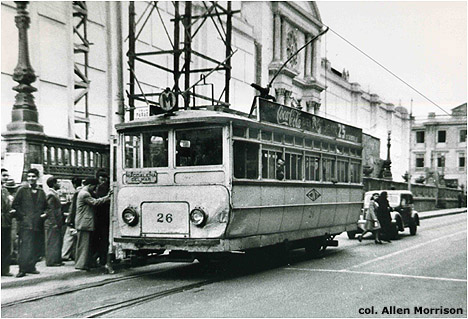
The transformation was unique: nothing like this has ever happened anywhere else in the world. (Three cheers for Inca ingenuity!) Here is another comparison of the trolleybus that turned into a tram. The first photograph below was taken in England before the vehicle was sent to Peru. The picture below it was taken 20 years later in Lima, after the reconstruction [col. AM]:
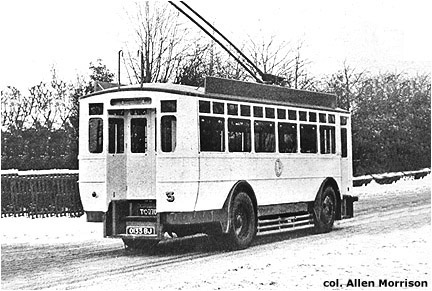
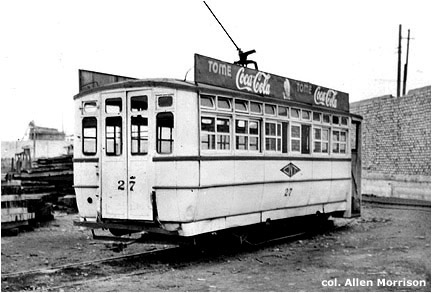
The abandonment of tram lines in the city center did not extend to the suburbs. In fact, LLPTC renovated its suburban lines and purchased new equipment for them from the United States. In October 1928 it ordered two large, late-model trams from J. G. Brill in Philadelphia [see Part 2]. The round "LLPTC" emblem is barely legible above the fleet number [col. AM]:
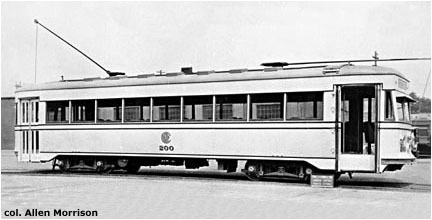
In July 1930 LLPTC ordered another 18 cars from Brill, which were similar to the vehicles in the 1928 order - with one prominent exception. Trams 202-219 were equipped with pantographs instead of trolley poles [col. AM]:
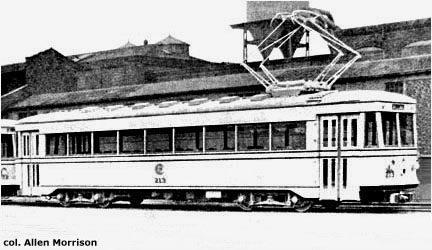
The cars with pantographs ran exclusively on the line between Lima and Callao [see map]. This situation continued until the tramway system closed in 1965. Trams on the Lima local lines and on the suburban routes to Chorrillos and San Miguel continued to use trolley poles. Here are two Callao trams at their Lima terminus in the late 1930s [col. AM]:

Likewise, beginning in the 1930s, the trams that provided local transportation in Callao, between Bellavista and La Punta [see map], carried bow collectors (liras in Lima). In other words, during their final 35 years of operation Lima trams carried liras in Callao, pantógrafos between Callao and Lima, and troles on the rest of the system. No other tram system in the world had an arrangement like that.
The photograph below, taken on New Year's Day 1957, shows a local tram with a lira in Callao [William Janssen]:
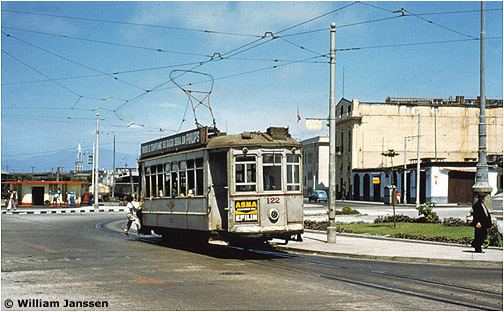
The following photograph, taken on New Year's Eve 1956, shows the same type car with a trolley pole in Lima. Breda motor tram 83 and trailer 11 are on the "M" suburban line to Magdalena and San Miguel [see map] [William C. Janssen]:

Financial difficulties and strikes plagued Lima Light, Power & Tramways in the 1930s and the company was nationalized in September 1934. The old LLPTC/EEA group was replaced by the new Compañía Nacional de Tranvías. [The new company should not be confused with the short-lived Compañía Nacional de Tranvía Eléctrico, which built the second electric line to Chorrillos in 1907: see Part 2.] A "CNT" emblem appeared on the city's trams and tram tickets thereafter. This specimen is from the Callao local line [see map] [col. AM]:
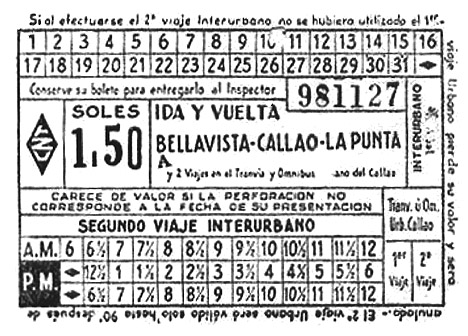
During the 1930s CNT closed its Miraflores local line and the extension from Chorrillos through the tunnel to La Herradura beach [see map]. Lima Railways closed its electrified freight lines: the Chorrillos railway in 1933 and the Callao line - Peru's first railroad, inaugurated in 1851 - in 1938. Otherwise, Lima's rail system seems to have remained unchanged during the next two decades.
The color photographs on this page were taken by North American tramway enthusiasts who visited Peru in the 1950s and 60s. The picture below shows an overloaded Italian 4-wheeler on route 2, approaching the Palacio de Gobierno on 21 May 1965 [Foster M. Palmer]:

Nine years earlier, on 31 December 1956, suburban tram 245, built by St. Louis Car Co. in the early 1900s, was still going strong. Location is Paseo de la República in the center of town [see map] [William Janssen]:
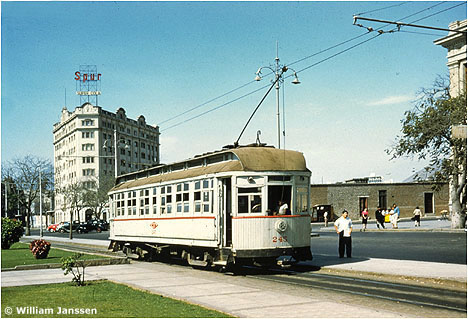
The two large Italian trams below, built in the 1920s, are in front of the Palacio de Justicia - a corner of which is visible in the photograph above. Breda motor car 271 is pulling a Breda trailer [see Part 2]. Like the ancient St. Louis vehicle above, the trams with seven arched windows ran on the suburban line to Chorrillos [see map] [Foster M. Palmer]:
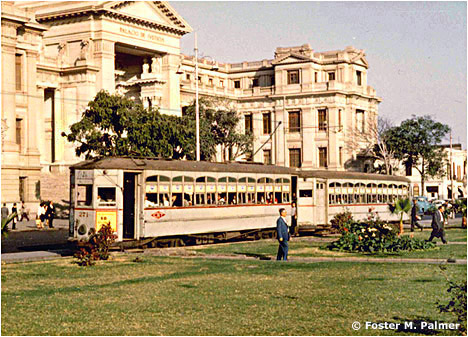
The origin of the car below is uncertain, but it may be one of the Italian trams shown above after "modernization". The side windows were rebuilt and the front windows enlarged. Location is Calle José Olaya in Chorrillos [see map]. The rusty rails in the foreground once led to La Herradura beach [William Janssen]:
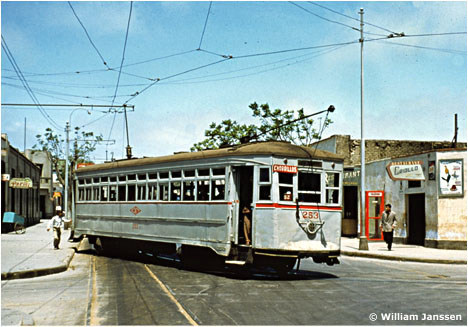
This photograph shows a small Italian tram on Av. Bertolotto that runs along the bluff in Magdalena del Mar that overlooks the Pacific Ocean [see map] [col. Elio Galessio]:
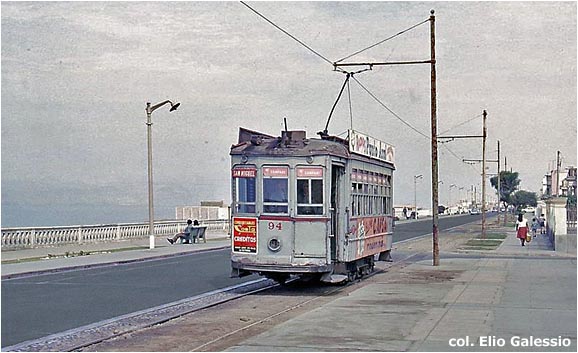
Another Breda tram at the same location in 1965 [see map]. The community across the water on the right is Chorrillos. Trams once tunneled under that mountain to reach La Herradura beach [see Part 2] [Foster M. Palmer]:
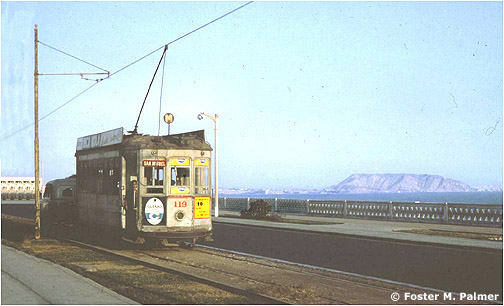
In Callao, in the other direction down the coast, a Brill tram of 1930 turns east onto Av. Saenz Peña to begin its journey back to Lima [see map]. The photograph was taken on 1 January 1957 [William Janssen]:
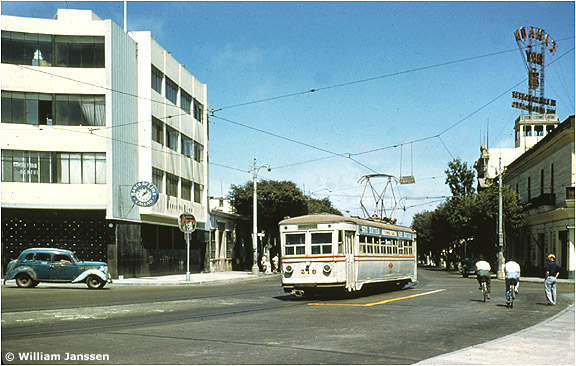
In 1947 the CNT purchased 20 used trams from the Third Avenue Railway in New York. The cars had been built by TAR in 1935 and ran in Manhattan until that year. (New York also sent two trams to Arequipa.) The New York imports were the only trams in Lima that ran on all three suburban lines - to Chorrillos, Magdalena and (with pantographs) Callao. Here is an extraordinary picture, taken in 1957 from inside an approaching tram, of New York car 228 on the high-speed track between Lima and Callao. The view is east, looking toward Lima [see map] [William Janssen]:
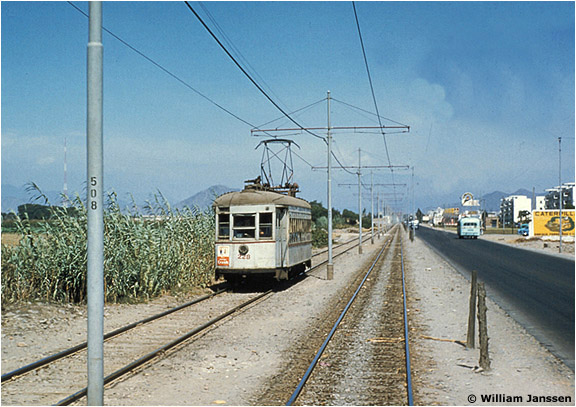
The photo below, taken in 1964, shows New York tram 229 arriving at Plaza 2 de Mayo in Lima, after its 10-km journey from Callao [see map] [Ray DeGroote]:

Young boys play the same games on every tram system on earth. This ex-New York car is probably number 228. Date of the picture is unknown [John Walther]:
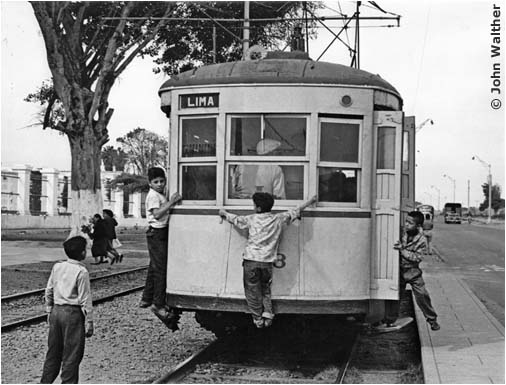
In spite of the "new" cars, Lima's tramway system deteriorated rapidly after World War 2. Most of the rolling stock was aging, parts were unavailable and track was poorly maintained. The unidentified tram below, photographed on Av. Reducto in Miraflores [see map], was typical of most of the fleet in 1964 [Ray DeGroote]:
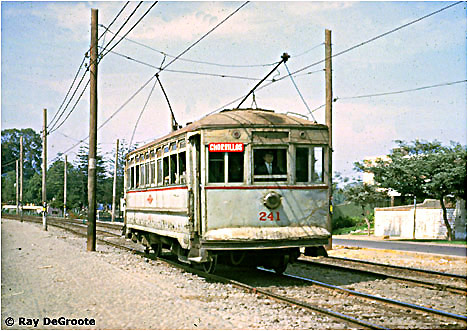
Trams provided only 15% of the city's public transportation in the 1960s and by 1965 there were only 24 cars - out of a former 150 - in operable condition. Revenue was meager and after 15 August of that year the CNT could no longer pay its employees. A thousand tramway workers struck the system at 6 am on Saturday 18 September 1965 and the trams never ran again. Efforts to restore service continued for a month, but on 19 October 1965 CNT officially declared the tramway system closed.
Construction began two decades later of a metro line along a north-south course parallel to, and several kilometers east of, the former Chorrillos rail lines. Five 6-car trains were ordered from Ernesto Breda in Italy - which had built trams for Lima 60 years before. The "Tren Eléctrico" was tested in 1990, but revenue service along the outer 10 km of the line did not begin until 2003. The inner 10 km of the route have yet to be built.
Part of the Chorrillos tramway opened in 1997!
See Part 4.
As on the other pages of this website, the author wishes to express his gratitude to Lima resident Elio Galessio for his invaluable assistance in the preparation of this survey. He also thanks Robert Stillman of the United States for the detailed track map that he drew of the Lima tramway system after a visit in 1963.
BIBLIOGRAPHY (in order of publication)
"The Spread of the Trolley Bus: English Vehicles for Peru" in Electric Railway and Tramway Journal (London), 10/2/1928, pp. 90-92; "Trolley Buses for Lima", 9/3/1928, p. 148. Two articles. Two photographs.
"Trolley Omnibuses for Peru" in Tramway & Railway World (London), 16/2/1928, pp. 73-74. Detailed article, two photos.
Santiago Antúnez de Mayolo. La Génesis de los Servicios Eléctricos de Lima. Lima, 1929. Fine general survey of electric transport in Lima. Brief description of the "línea de trollebuses" on p. 33.
"Lima, Light & Power Company (Empresas Eléctricas Asociadas)" in Moody's Manual of Investments (New York), 1937, p. 898. Financial history of the system.
"Trolley Buses Throughout the World" in Transit Journal (New York), 3/1939, pp. 82, 83 & 112. Source of the trolleybus picture on this webpage - the only known view of a trolleybus running in Lima.
"From Broadway to Calle Lampa" in Grace Log (New York), 3-4/1947, p. 22. Transfer of New York trams to Peru. Four photographs.
Allen H. Berner. "The Trolleys and Lines of Lima, Peru" in National Railway Historical Society Bulletin (Philadelphia), Third Quarter 1958, pp. 8-11. Brief survey, seven photos.
W. E. Hall. "Trolley Lines of Lima, Peru" in Headlights (Hoboken), 8/1959, p. 11. Short description, eight photos.
Alberto Regal. Historia de los Ferrocarriles de Lima. Lima, 1965. A monumental work. History and description of all the railways and tramways in the Lima area, including the Callao local lines (chapter V); Lima local lines (IX); Lima-Chorrillos lines (X); Lima-Callao line (XI); Lima-Magdalena lines (VIII). Numerous photographs and excellent maps.
"Tranviarios inician paro" in El Comercio (Lima), 19/9/1965, p. 1. Unpaid tramway employees strike the rail system.
"Tranvías vendidos como chatarra no cubrirían deuda al personal" in El Comercio (Lima), 4/10/1965, p. 5. Long description of the CNT problem.
"Los Tranvías" in El Comercio (Lima), 11/10/1965, p. 2.
"No volverán a circular más los tranvías en Lima" in El Comercio (Lima), 20/10/1965, p. 1. Official announcement that the tramway system is closed.
"Despedida al Tranvía" in El Comercio (Lima), 22/10/1965, p. 2. Long editorial: farewell to the tram.
"Tranvías no Volverán a Circular en Lima" in La Prensa (Lima), 22/10/1965, p. 1. Front page feature article.
"Tranvías: Condenados a Muerte" in La Prensa (Lima), 23/10/1965, p. 10. Trams condemned to death.
Trevor Stephenson. "Lima's Forgotten Trams" in Lima Times (Lima), 25/11/1983, pp. 6-8. First of several illustrated articles which the author will recycle in the book cited below.
Municipalidad de Lima Metropolitana. Planos de Lima, 1613-1983. Lima, 1983. Folio of 30 maps, many showing tram routes.
Juan Carlos Arroyo Ferreyros. "El Tranvía" in Concertando (Lima), 9-10/1994, pp. 7-10. Good historical survey. Data mostly from Regal, above. Four photos, seven charts.
Trevor H. Stephenson. Peruvian Trams and Railways: An Illustrated History. London, 1995. Lima railways and tramways, pp. 23-57. Brief text, unidentified illustrations, maps copied (without credit) from the Regal work noted above.
César Jiménez. Historias de los tranvías en Lima. [1998] Nice historical survey of tramway development. Text, 12 photographs, diagrams of the urban lines, enlargeable map of the suburban network.
Go to
Part 1: 1864-1904
Part 2: 1905-1927
Part 4: 1997-
The first pages of this website
were uploaded on
30 December 2003
Also see my pages on
The Tramways of Arequipa
and
The Other Tramways of Peru
Please send
comments, corrections & suggestions
to
Allen Morrison
Visit my homepage about
Electric Transport in Latin America
Copyright © 2004-2104 Allen Morrison - ALL RIGHTS RESERVED
|




















